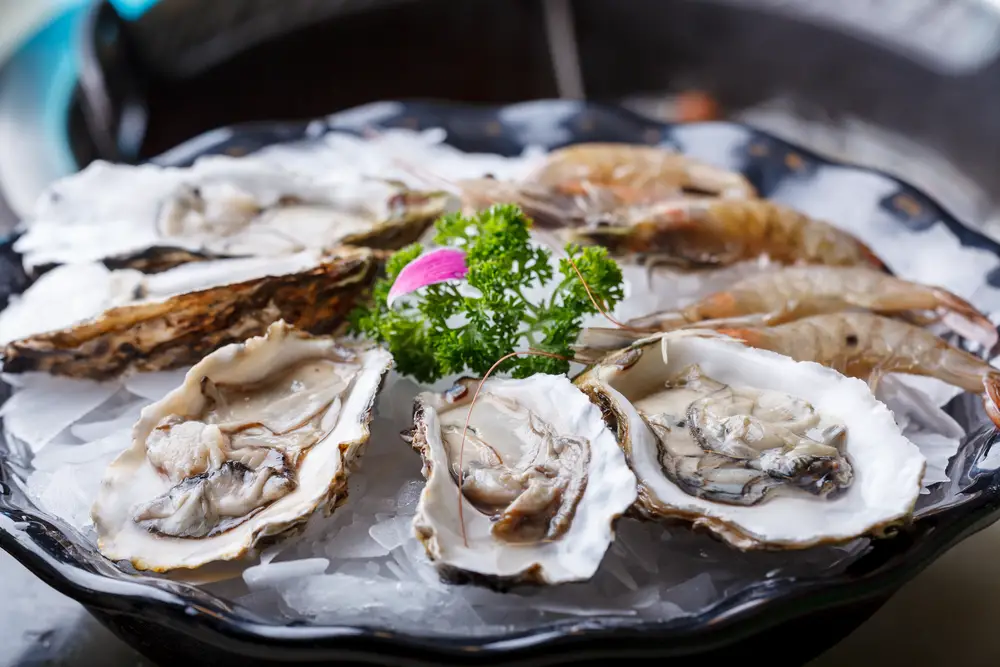Just like most foods, oysters are perfectly safe to be frozen. In fact, they don’t even require that much preparation prior to freezing as it is fine to freeze oysters while they are still in their shell.
So, if you have purchased some oysters that you know you do not want to eat yet, there’s no need to stress because you can simply throw them in the freezer until a later date.
Alternatively, it is also possible to freeze oysters once they have been shucked, but we’ll take a more detailed look at that later on.

While it can be tempting to shuck the oysters prior to freezing (as this will ensure they take up less space), it is best to freeze the oysters while they are still in their shell. This is because it will help retain the flavor of the oysters, and it will also create less mess.
Before you freeze oysters in their shell, it is best to give them a deep clean to remove any sand, and make the defrosting process less messy.
Once this is done, simply place the oysters into a ziplock freezer bag, label them with the date, and place them in the freezer until you want to use them.
How to freeze Fresh Oysters
We’ve already spoken about how to freeze oysters in their shell, but how do you freeze these oysters when they are fresh out of the ocean? Well, the first thing that you need to do is give the oysters a clean.
This will remove all the sand and dirt off of the shell, and ensure that it is clean ready for freezing. This will also give you the opportunity to identify which oysters are alive, and which have already died.
When you are cleaning your fresh oysters, you can test to see if the oysters are alive by tapping on their shell. If the shell tightens once you tap it, then the Oyster is alive.
If there is no movement, or the shell is open, then the Oyster has already died, and you should toss these aside into the trash.
Then, if you plan on freezing your fresh oysters in their shells, simply place them into freezer bags and label them with the date, before placing them safely in the freezer.
How to freeze Raw Oysters
As you probably already know, fresh oysters are already raw, so the process of freezing raw oysters is the same as the process of freezing fresh oysters.
However, if you are planning on freezing raw oysters with the intention of eating them raw in the future, then this simply isn’t possible.
It is only safe to eat raw oysters because the oysters themselves are still alive up until the moment that you eat them. This ensures that they do not turn or go off, and means that you are not at risk of any nasty bacteria.
But, when you freeze raw oysters, unfortunately, the oysters will die. So, even though they were perfectly safe to eat raw before you froze them, you cannot eat them raw once they have been frozen.
Instead, you will only be able to use the oysters in cooked dishes, such as casseroles and soups. So, before you decide to freeze your raw oysters, it is important to remember that you will not be able to eat them raw once they have been frozen.
How to freeze Shucked Oysters
So far, we’ve only spoken about freezing oysters in their shell. But, as we said earlier, it is also perfectly fine to freeze oysters that have been shucked too. The process is slightly different, so let’s take a look at what you need to do.
As we said earlier, it is best to freeze oysters in their shell where possible, but if you have limited space we understand that you might be unable to do this.
So, if you have to freeze your oysters shucked, you should begin by shucking all the oysters that have not yet opened. Once this is done, you should separate the oyster liquor from the meat.
inse the oyster meat under the tap to get rid of any sand or dirt, and strain the oyster liquor to remove any large pieces of shell or sand.
Then open up a freezer-safe bag, and add both the oyster meat and liquor into it, ensuring that the oyster meat is completely submerged in the liquor. Then label the bag with the date, and place it in your freezer ready for future use.
How to freeze Oysters Rockefeller
There’s no denying that oysters Rockefeller is a very yummy dish, but what happens if you have leftovers? Can you freeze them? In short, the answer is yes. This might come as a surprise as you probably expect that you can’t freeze these due to the way that they are prepared.
But these oysters and sauce do freeze rather well. However, once they have been frozen, you will not be able to consume them raw.
Luckily, as these oysters are topped with sauce and a variety of flavorings, it is difficult to tell the difference when they are cooked to when they are raw.
So, to freeze them, all you have to do is tightly pack them with cling film (to ensure that the meat does not come away from the shell), and then pack them into a freezer bag.
Once you have labelled the bag with the date of freezing, you can then place them in the freezer until you want to use them.
When you do want to use them in the future, you will then need to place them on a baking tray and cook them at 400 degrees for approximately 20 minutes before consuming.
How long can Oysters be Frozen?
Although, it can be easy to think that once something has been frozen, it is safe to eat indefinitely. However, this is not the case. Even when something is frozen, it still has a limited shelf life, so how long can oysters be frozen for?
Just like most things that are frozen, oysters have a much longer shelf life in the freezer than they do fresh. So, once they have been frozen, oysters will be perfectly safe to eat for up to 12 months.
But, it is best to think of these 12 months as the best before date, rather than a use by date. Once they are frozen, oysters cannot go off. So, they are still safe to eat, even once these 12 months have passed.
However, it is recommended that you eat them within the first 12 months as this is how long they will remain good quality for. Once these 12 months pass, the condition of the oysters will begin to deteriorate, however they will still remain perfectly safe to eat.
How to Thaw Frozen Oysters
So, how do you thaw your frozen oysters when you want to eat them? Let’s take a look. This probably isn’t going to come as a surprise to you if you have thawed something before, but the best way to defrost your oysters is to simply place them in the refrigerator.
Like many dishes which have been frozen, oysters thaw the best when it is done slowly, and the perfect way to do this is by using the fridge.
Unfortunately, this does mean that you will need to plan when you want to use your oysters in advance.
The best time to move your frozen oysters from the freezer to the refrigerator is the night before you want to use them, as this allows them to completely thaw ready for use the next day.
However, if you plan on using the oysters at lunchtime, you should instead move them to the refrigerator at midday the day before. This is because it takes roughly 24 hours for frozen oysters to thaw.
How to Thaw Oysters in Shell
As the process was slightly different for freezing oysters depending on whether they were shucked, or in their shell, you might expect the thawing process to be different too. However, it actually isn’t.
So, even if you froze your oysters in their shell, all you have to do is move them from the freezer to the refrigerator roughly 24 hours before you plan on using them. This is very important if you froze your oysters in their shell as this could cause them to take a little longer to thaw.
The most important thing when it comes to thawing oysters is that you cook them fairly quickly after they have defrosted. If you delay doing this, you will be giving the oysters time to turn, which could make them unsafe to eat.
This is why it is very important that you monitor the thawing process of the oysters so that you can cook them as soon as possible afterwards.
Remember what we said earlier about eating thawed raw oysters, so ensure that you always cook them before consumption. Otherwise, you are at risk of food poisoning.
